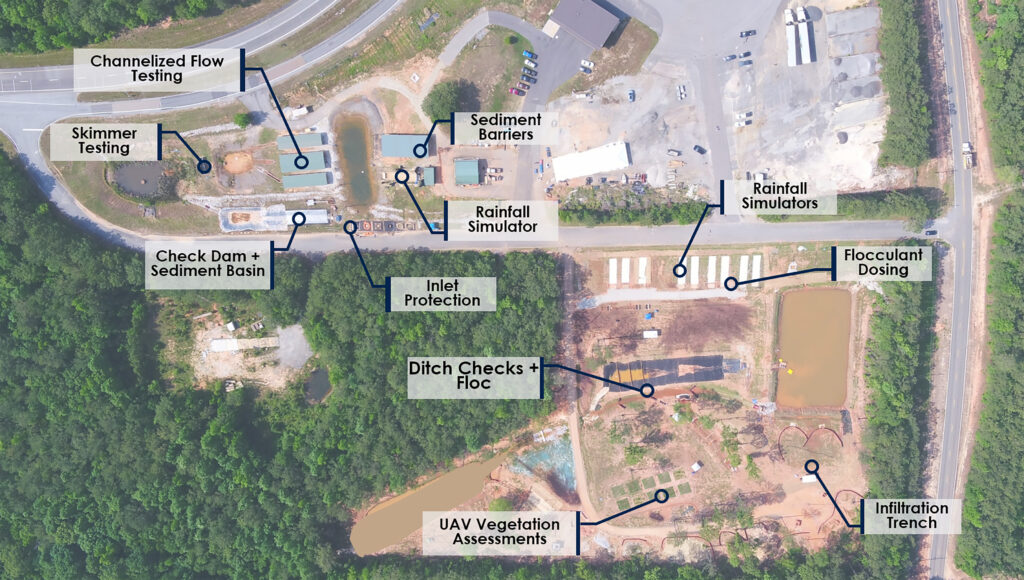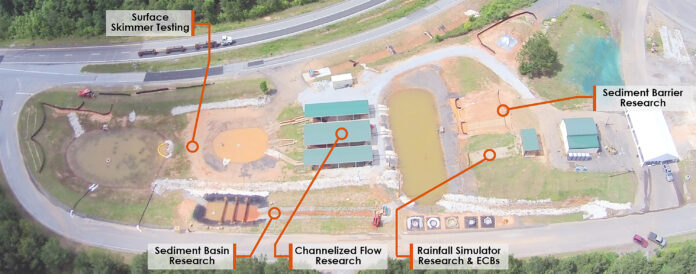The success of the Alabama Department of Transportation’s (ALDOT’s) Construction Stormwater Management program in Alabama, USA, started as many facets of life do: with failure. At the time, construction philosophy was to get the job done as fast as possible and as cheap as possible. In the mid-2000s, the Department contracted a state route relocation project including grade, drain, bridges and bridge culverts. This project was in one of the rainiest parts of the country, with soils comprised of highly erodible sands and fine Alabama red clay. At the time, the Department’s knowledge and use of best management practices (BMPs) were limited.
This project would serve as the perfect storm and a wake-up call for the Department to overhaul its construction practices. The hydrology, erodible soils, limited BMPs and large amounts of exposed erodible material resulted in significant sediment losses that contaminated a local drinking water reservoir, which resulted in regulatory penalties. ALDOT needed to regain the trust of the regulators and the public.
ALDOT’s response was an “all-hands-on-deck” approach with buy-in from the highest levels of leadership in the Department, such as the director and chief engineer, to the boots on the ground. The Department created an Environmental Construction Section for statewide oversight as well as stormwater coordinators to serve as managers for each area of operation, but that was just the beginning of ALDOT’s journey into stormwater management.
For the Department to be successful, it required a culture change inside and outside of ALDOT. ALDOT found passionate people to manage the Construction Stormwater Management program and push it to evolve. To provide environmental quality assurance and change the Department’s view by regulators, ALDOT became a qualified credentialed inspector (QCI) training provider that is accredited by the state environmental regulatory agency, the Alabama Department of Environmental Management. This training provides continuity across the state and educates inspectors. To go beyond what is required by regulators, turbidity monitoring was implemented on priority construction sites and projects greater than 10 acres (4 hectares).
Part of the culture shift was the acceptance of the need for stormwater management. For some time, the words “stormwater” or “environmental” had a taboo connotation. It took passionate people to convince internal and external entities that these facets are no different than other aspects of transportation construction that are required, such as taking soil borings or obeying geometric controls.
With this shift, the Department also needed a new construction philosophy. ALDOT created and adopted the Five Pillars of Construction Stormwater Management. The Pillars are implemented in order of effectiveness and economy. These pillars are to manage communication, work, water, erosion and sediment. This philosophy significantly advanced ALDOT’s Stormwater Management Program to the forefront nationally.
At this time, ALDOT began to evaluate the volume of material to be moved during construction using mass haul diagrams and restricting acreage. The Department also saw the need for stormwater oversight in the design side of the house and created Stormwater Planning and Permitting sections while implementing phased construction for the erosion and sediment control plan sheets. ALDOT also created Construction Best Management Practice Plan and Stormwater Management Plan templates with an in-house built Stormwater Tracking System to ensure regulatory compliance.
Furthering the culture shift, to look beyond just in-house, ALDOT made friends and partners. The Department made advancements and was willing to go above regulatory requirements.

Also, by being completely transparent with operations, ALDOT increased communication with regulators and built a mutual appreciation. At the forefront was the shared goal of clean water. The nature of construction can be messy at times, and in the Department’s infancy, mistakes were made. These mistakes often gave ALDOT a bad reputation with environmental special interest groups and the public.
To change that reputation and garner goodwill with regulators and special interest, the Department demonstrated its level of excellence. ALDOT became an active member of the American Association of State Highway and Transportation Officials (AASHTO) Product Evaluation & Audit Solutions (formerly the National Transportation Product Evaluation Program) and the International Erosion Control Association. To keep evolving, the Department also plans to partner with brighter minds that are also passionate about clean water.
ALDOT partnered with Auburn University to start performing applied research to enhance its BMPs. ALDOT sponsored the initial development of the Stormwater Research Facility, which has expanded significantly and been a valuable resource for the Department (Figure 1). ALDOT has sponsored research projects that include silt fence and sediment barrier enhancement, proper flocculant usage, rainfall simulators for determining the effectiveness of mulching practices, and infiltration swales.
The Auburn University Stormwater Research Facility has expanded to provide research, testing and training. Their research provides a scientific understanding of stormwater management practices used to minimize impacts of construction and urban and agricultural stormwater runoff. They serve as an independent third party providing standardized testing of manufactured stormwater practices. The training provides knowledge gained through research to designers, practitioners, regulators and the general public to showcase proper techniques for installing, maintaining and inspecting stormwater management practices (Figure 2).
Passionate people are infectious. As ALDOT found those people at Auburn University, the Stormwater Research Facility, in turn, found passionate people across the county and internationally. It eventually became associated with the International Erosion Control Association. Several DOTs have followed ALDOT and are performing research at the Auburn facility to bolster their own stormwater programs.
On another branch of the stormwater tree, ALDOT sponsored and facilitated the creation of the Alabama Stormwater Association to help foster the growth of local construction and post-construction stormwater programs. The Department also partnered with environmental special interest groups such as the Soil and Water Conservation Society and serves as a member of the Alabama Erosion and Sediment Control Steering Committee. ALDOT helps provide education and training statewide while advancing stormwater practices in Alabama.
ALDOT strives to find inventive ways to enhance the Construction Stormwater Management Program. One of the most recent advances was the introduction of a program to do inspections using unmanned aerial systems (UAS). Using drones enhances the inspection process, helps identify areas of concern and provides invaluable documentation. ALDOT is researching the use of drones to determine vegetation establishment and desired species confirmation to ensure final stabilization. Alabama is a vast state that encompasses approximately 53,000 miles2 (137,000 km2), and the UAS inspection program allows leadership the ability to instantly review projects around the state from their office.
Moreover, ALDOT’s latest endeavor to enhance stormwater management involves sponsoring the creation of a professional certification agency for erosion and sediment control practitioners. This venture will be provided by an independent third party and is being backed by the Alabama Department of Environmental Management. Alabama has diverse soils and hydrology. By being trained on these nuances, the most effective best management practices and proper inspection techniques, Alabama and ALDOT plan to stay at the forefront of stormwater management.
A successful construction stormwater management program requires buy-in from the top to the bottom of an organization. Entities must find passionate people with a vision for advancement and give them the tools and resources to be successful. Networking and partnerships foster the journey. And don’t be afraid of a little R&D; not just “research and development,” but “rip-off and duplicate” other successful programs.
About the Expert
- Richard Klinger, PE, is the State Environmental Construction Engineer for the Alabama Department of Transportation (ALDOT). He also serves as the Director of ALDOT’s Qualified Credentialed Inspection Program and the erosion and sediment control expert for the Product Evaluation Board.












